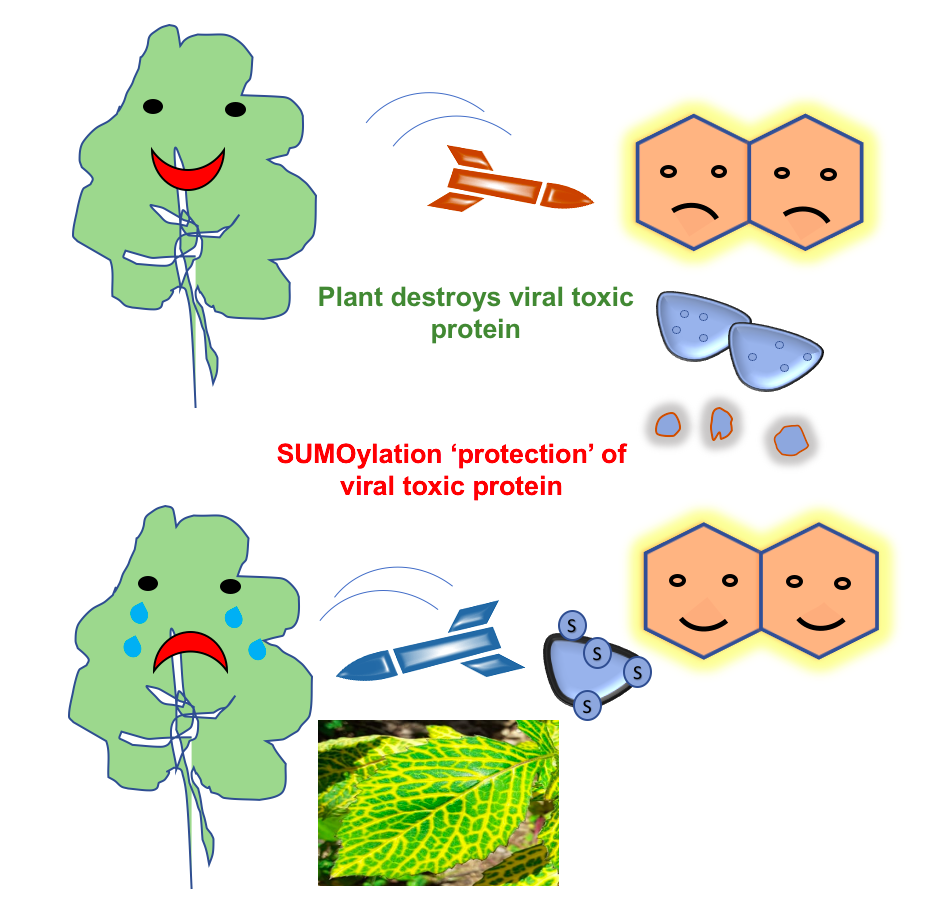Plants destroy viral toxic proteins as part of their defence, while the viruses use the plant machinery to protect their toxic proteins and cause symptoms. We can consider these a new set of "arms" in the plant-virus "arms race".
Viruses are frightening, yet they are fascinating. Unlike other bugs that trouble us and other living organisms, viruses require a living ‘host’ where they reside, so that they can make use of all the host’s raw materials to make their proteins-the building blocks of all life. Viruses are tiny and have space to print a very few proteins in their genome, and even with a few proteins, they can damage the host spectacularly. Thankfully, not all living individuals are hosts for viruses. In fact, like humans, all organisms are happy to avoid the viruses, simply by not providing a favourable condition. However, if the viruses cannot be avoided, living beings fight off the viruses.
How does the virus and its potential host interact? Very simple, they just fight each other as if their lives depends on it, and they do. Just like the mighty geopolitical powers of Earth, they indulge in an arms race, each projecting and deploying these potentially lethal weapons against each other. Such a fight can involve a series of arms, each new weapon more potent than the previous one. Finally, either the virus will end up as a winner and claim all the host has—including its protein-making machineries so that all the host’s resources are at the virus’s disposal—or, the host wins by removing all traces of the virus.
These interactions are often called ‘zig-zag interactions, since there is a counter-defence against each of the weapons to tip the balance on either side. The host has weapons to “defend” against the virus; on the other hand, the virus “counter-defends” this by using its own arms. The host then comes up with “counter-counter defence”. These terminologies look as if two countries are at war, but for those who study these interactions, these are fascinating layers of battles.
In such fights, one would have thought plants being stationary might find it difficult to escape from viruses or virus-carrying insects. However, plants are ancient, they were some of the first living beings on earth. In this timescale, they have built up arms to counter all kinds of threats, including those coming from viruses. Usual mechanisms deployed to target viruses include a protein-cutting ‘Dicer’ machinery that will chop off viral genomes so that viral proteins are not made. Viruses have evolved counter-defence strategies against such cutting machineries to stop this process.
In the Epigenetics Lab at NCBS, we work on a ‘gemini’ virus that infects a wide range of plants. We have identified a previously unknown step in the arms race. Here the weapon used by the plant and the virus is in the form of small but important changes to proteins. Proteins as building blocks are usually deployed as is, but small changes increase their lifespan, their interaction with other proteins, as well as their ability to cope under attack by other protein-destroying machineries. The virus we study typically brings in vein-clearing symptoms, where the virus moves in specific tissues in the leaves and a beautiful vein-clearing symptom is formed. We previously isolated and cloned the disease-causing virus named Synedrella Yellow Vein Clearing Virus. The vein-clearing symptoms make the leaf even attractive to human eyes, while internally, the plant often struggles to make flowers and fruits.
Our lab at NCBS has worked out the mechanism adopted by a viral protein to suppress plant-defence responses. We have isolated a protein named βC1 from this virus. βC1 is referred to as a “pathogenicity determinant” which helps in successful infection, and also in the intercellular movement of the virus inside the plant system. We find that this protein is targeted for specific degradation by the plant’s defence system. The multifaceted viral βC1 protein avoids its degradation by utilising plant machinery to undergo a modification known as SUMOylation. The work spearheaded by Ashwin Nair has shown that this particular modification of βC1 holds the key for the success of the virus in weakening the plant defence system. We collaborated extensively with experts, Kiran Sankar Chatterjee and Dr. Ranabir Das, to understand the fine details of the interaction between βC1 with the host modifiers. Our work has shown that the inability of βC1 protein to undergo this modification leads to its inefficiency in causing disease in plants. We believe this work is a very significant addition to the general understanding of the molecular mechanism of plant-viral interactions.
All virus-induced symptoms lead to compromised growth and reproductive ability of plants upon infection. This compromise is severe in agricultural ecosystems where monocropping is followed, simply because viral movement and spread is easier as their hosts are in abundance and close by. Increasing crop loss owing to viral infection necessitates research in order to understand the mechanisms of infection. We believe this study has helped to identify novel tools to enhance viral resistance.
The publication appears in the journal BMC Biology: https://bmcbiol.biomedcentral.com/articles/10.1186/s12915-020-00843-y










0 Comments